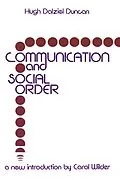In this highly influential study of art forms as models for a theory of communications, Hugh Dalziel Duncan demonstrates that without understanding of the role of symbols in society, social scientists cannot hope to develop adequate models for social analysis.
Inhalt
One: Symbolic Contexts of Social Experience in Freud, Simmel, and Malinowski; 1: Symbolic Interaction in Freud's Work; 2: Georg Simmel's Search for an Autonomous Form of Sociability; 3: Malinowski's Theory of the Social Context of Magical Language; Two: The Self and Society as Determined by Communication in James, Dewey, and Mead; 4: Society As Determined by Communication; 5: Communication and the Emergence of the Self in the Work of George Herbert Mead; 6: The Final Phase of the Act; 7: The Problem of Form in Mead's Theory of the Significant Symbol; Three: The Function of Symbols in Society: an Application of Burke's Dramatistic View of Social Relationships; 8: Burke's Dramatistic View of Society; 9: Social Order Considered as a Drama of Redemption Through Victimage; Four: Burke's Sociology of Language; 10: The Structure and Function of the Act in the Work of Kenneth Burke; 11: A Rhetoric of Motives; 12: The Rhetoric of Social Order; Five: Social Mystification in Communication Between Classes; 13: Toward a New Rhetoric; 14: Social Mystification and Social Integration; 15: Reason and Hierarchal Disorganization; 16: The Rhetoric of Ruling; 17: Rhetoric as an Instrument of Domination Through Unreason; 18: Social Order Based on Unreason; Six: A Sociological Model of Social Order as Determined by the Communication of Hierarchy; 19: Social Order as a Form of Hierarchy; 20: The Communication of Hierarchy; 21: Hierarchal Address; 22: A Sociological View of "Inner" Audiences; Seven: Hierarchal Transcendence and Social Bonds; 23: Social Transcendence; 24: Equality and Social Order; 25: The Establishment of Money as a Symbol of Community Life; 26: Money as a Form of Transcendence in American Life; Eight: The Social Function of Art in Society; 27: Comedy and Social Integration; 28: The Comic Scapegoat; 29: Comedy as the Rhetoric of Reason in Society; 30: Tragic and Comic Sexual Themes Compared; Nine: By Way of Conclusion; 31: A Sociological Model of Social Interaction as Determined by Communication
